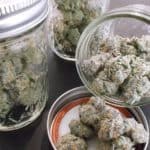Drying and curing cannabis are the last two things to do after a big chunk of all the work is officially complete. One of the biggest mistakes ever made in the cannabis industry is assuming the work is done as soon as the crop has been chopped down and harvested. How you dry and cure your freshly harvested cannabis plants does matter, so follow this complete guide if you're ...
All those weeks of giving life ended with one clack of the sheers, dropping the mighty plant.
After the plant is cut down comes the processing of the flowers. You must dry the cannabis, trim it, and cure it.
Would you like an ACMPR medical license to grow up to 500 plants at home?
Drying Cannabis
DO NOT:
Do not dry in a grow room with actively growing plants
Never dry in closed containers
There are several key factors that must be considered when drying cannabis. These include temperature, humidity and air flow. A slight deviation from the ideal conditions can have a negative impact on the quality of the final product.
A climate-controlled drying container, such as a large appliance or grow tent, can be useful for drying. You can also build your own using plasterboard and wood walls. If you require more control, a closet or small space will dry faster.
Brown paper bags are great to keep humidity levels above the ambient amount and reduce evaporation. Measure the moisture content of your bag with a hygrometer. If the humidity is more than 50%, you can fan it to remove moist air.
Drying is just as important as growing, and a flawed drying process can lead to the destruction of even the most beautiful buds. Drying marijuana means that the buds are reduced to between 10 and 15% water, depending on how crisp you want the final product.
Ideal conditions will see most of the moisture evaporate from the buds within the first three days, and then the drying process should slow down. The more time the buds are dried, the more THC is converted to CBN and other cannabinoids. Even with the same strain, you can experience a slight change in your effects, such as a higher or more stoned effect or a more physical high. It is at the expense of the more delicate, lighter essential oils (terpenes) when cannabis is dried too quickly or too long. The terpenes that are most volatile and lighter have the lowest evaporation point. They evaporate first in drying, ahead of the water.
Drying & Racks
Cannabis drying racks enable small-scale growers as well as commercial and industrial growers to produce high quality cannabis products.
Types of racks:
- Drying rack frames
- Tray truck
- Pan racks
Get started on your medical grow license today!
Step 1: Enter your email to book your ACMPR license appointment today
- Compassionate Practitioners Required
- Help with Approvals
- Low Cost Renewals
- No Stress Appointments
Curing Cannabis
After harvest, the crop begins to deteriorate as enzymes, aerobic bacteria, and other microorganisms break down sugars and starches. Curing cannabis forces the plant’s ability to use all the sugars, starches, and excess nutrients it has before it can dry out.
Although drying and curing are very similar, there is a subtle distinction. Drying can occur after the buds have been cut in drying trimming or after the buds have been trimmed in wet trimming. Buds should be dried in a drying room or on a drying rack. After the buds have been trimmed and moisture removed, curing is done. Curing involves placing dried buds in containers to prevent moisture loss and preserve aromas and flavors.
Curing is perhaps the most crucial aspect of growing marijuana. The curing process continues to draw moisture from the center of a bud towards the outside. Proper treatment allows you to preserve weed for more extended periods without worrying about mold or the loss of cannabinoids. Well-cured flowers can be stored in an airtight container for up to 2 years in a cool and dark place.
Plastic bags are not suitable for curing because they are not impervious to oxygen and can be degraded when in contact with certain terpenes found in cannabis. The trimmed buds should be in an airtight container. You can use a wide-mouthed quart or half-gallon glass mason jars or ceramic vessels, but metal and wood are also options.
What is the average time it takes to cure cannabis?
Your cannabis should cure after two to four weeks in the containers. Some prefer to wait for four and eight weeks, while others may need six to twelve months.
Trimming Cannabis
Trimming removes excess leaves from marijuana plants before or after drying. It will make your marijuana buds smoother to smoke. The growers prefer to remove the trimmed leaves separately in order not to waste any of the compounds. The leaves, however, have a much less THC concentration as compared to the actual bud. You can use either your hands or an auto trimmer to trim the buds properly for maximum potency.
After harvest, the trimmings are taken from a cannabis plant. The trimmings include sugar leaves and bits of cut-off cannabis buds. They are also known as trichomes or kief.
Often, trimmed buds are considered to be of higher quality. When you see buds in magazines, dispensaries, or online, most buds have been wholly manicured. Some reasons to trim cannabis buds are appearance, better smell, easier on the throat when smoked, and higher THC concentration.
Other reasons to trim include:
- Lack of sunlight causes leaves to die.
- Low branches on the plant have less chance of receiving sunlight.
- Bud lower down that don’t receive much light.
Don’t trim too many of the stems or pieces of bud when trimming them with a trimming knife. It is considered excessive trimming.
Wet trimming vs dry trimming
There are two types of wet and dry trimmers. Wet trimmers cut fresh (wet), marijuana flowers. Dry trimmers work with dried material. It all depends on the situation.
When they dry, the buds expand and puff up. This makes it more attractive to have your buds trimmed wet.
Wet trimming advantages:
- Trim quickly in order to save labor costs.
- Limited drying space
- Humid climate
- Mold risk is reduced
- Drying takes up less space
- Buds look nicer
- Easier
- Faster
Dry trimming advantages:
- Quality of the buds is the most important thing
- You are not capable of completing all trimming in one sitting
- Get your harvest off-site as soon as possible
- Buds of higher quality
- There is no need to trim everything at once
After harvesting the wet buds, remove any fan leaves or sugar leaves. The cannabis flowers can then be dried without leaves. Hang the buds to dry if they are not completely dry. This can take up a lot space. They can be dried on a drying rack after being trimmed.
Pruners
Pruning shears deal with cutting away nuisance branches; these are excellent for the earlier stages of your plant’s life. These blades are incredibly sharp and can easily cut through small branches and makes them practical and fast. These blades are durable thanks to ultra-fine polishing technology.
Scissors and snips
You can use trim scissors or bud trimming scissors to remove unwanted parts from the cannabis plant. Wet buds require trimming. The leaves will not dry at the same speed.
Automatic trimmers
Automated bud trimming machines make it easy to trim cannabis flowers. These machines save time and money and can be paid for in a matter of days by the saved labor costs.
Buckers
The most tedious task in cannabis processing is trimming. However, bucking and de-stemming buds are a close second. Two types of automated buckers are available: high performance and gentle cut. It all depends on what you need and how large your harvest is. Gentle Cut Bucking Machines are for low yield with high quality. If you have to process large quantities of material, high capacity Bucking Machines are the best choice.
CannaBrush
The CannaBrush is a fantastic brush for cannabis flowers and ideal for removing leaves with minimal impact on the final product. Quickly remove the leaves after harvesting and save a lot of time cleaning your buds. Brushing is an easy motion that puts minimal strain on your buds. The brush will feel natural when using the proper technique and can be easily cleaned by gently removing the resin tips and freezing them.
Sprayers
Low volume electrostatic spraying is the best option for those who have limited resources or want to provide foliar feeds to their cannabis and hemp plants. Foliar feed is not intended to replace the natural process by which plants absorb nutrients. Foliar feeding can be an excellent way to address any nutrient deficiencies and fix any nutrient deficiencies.
Packaging
As with many consumable goods, quality can decline over time. Mylar bags are a popular choice for storage and can keep weed fresher than plastic and stop odors from entering.
Prescription containers and bottles, such as the ones you use to store other medications, are also trendy. These containers can be seen through to let you know the product’s quality.
Glass weed jars remain very popular for many reasons. These jars are also known as mason or canning jars and are safe from oxygen.
A climate-controlled drying container, such as a large appliance or grow tent, can be found. You can also build your own using plasterboard and wood walls.
Would you like to legally grow up to 500 medical cannabis plants at home?
- Compassionate Practitioners
- Help with Approvals
- Low Cost Renewals
- No Stress Appointments
Trimming Marijuana for Creating Beautiful Buds
When harvest time rolls around, trimming marijuana is probably not on your mind. With your latest grow op is done, you're likely thinking it's time to sit back and relax with a massive joint of home-grown cannabis in hand. Yet there's still a big job ahead of you: trimming your buds. It's not rocket science, but trimming marijuana does come with its challenges. Deciding ...



